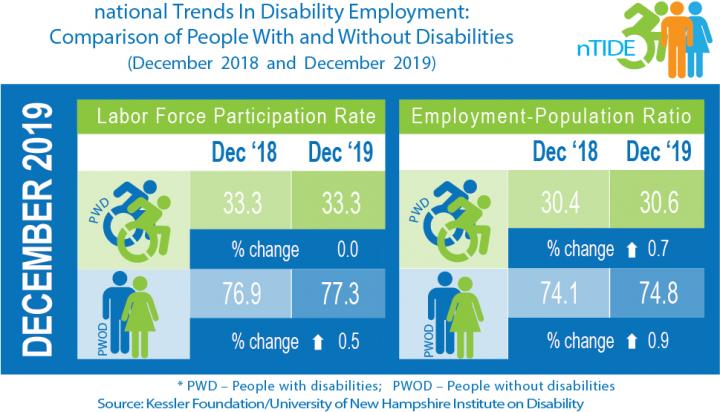Kessler Foundation and University of New Hampshire nTIDE Report — featuring The Washington Center’s LISD — an academic internship program for college students with disabilities supported by AT&T, Kessler Foundation, and Prudential Financial

Credit: Kessler Foundation
East Hanover, NJ – January 10, 2020 – Job gains were minimal for Americans with disabilities at the close of 2019, according to today’s National Trends in Disability Employment – Monthly Update (nTIDE), issued by Kessler Foundation and the University of New Hampshire’s Institute on Disability (UNH-IOD).
In the Bureau of Labor Statistics (BLS) Jobs Report released Friday, the employment-to-population ratio for working-age people with disabilities increased slightly from 30.4 percent in December 2018 to 30.6 percent in December 2019 (up 0.7 percent or 0.2 percentage points). For working-age people without disabilities, the employment-to-population ratio also increased from 74.1 percent in December 2018 to 74.8 percent in December 2019 (up 0.9 percent or 0.7 percentage points). The employment-to-population ratio, a key indicator, reflects the percentage of people who are working relative to the total population (the number of people working divided by the number of people in the total population multiplied by 100).
“The labor market’s continuing strength seems to be benefiting workers with disabilities,” said John O’Neill, PhD, director of employment and disability research at Kessler Foundation. “This gain in the employment-to-population ratio is similar to what we saw last month. In the new year, we hope to see a return to the positive pattern of 2016-2017, when there was steady improvement in the employment situation for people with disabilities.”
The labor force participation rate for working-age people with disabilities was unchanged from 33.3 percent in December 2018 to 33.3 percent in December 2019. For working-age people without disabilities, the labor force participation rate increased from 76.9 percent in December 2018 to 77.3 percent in December 2019 (up 0.5 percent or 0.4 percentage points). The labor force participation rate is the percentage of the population that is working or actively looking for work.
“Despite the improvement we saw this month, the employment-to-population ratio for people with disabilities has flattened since the beginning of 2018,” noted experts at the University of New Hampshire Institute on Disability.
In December 2019, among workers ages 16-64, the 4,646,000 workers with disabilities represented 3.1 percent of the total 147,720,000 workers in the U.S.
Beyond the Numbers
Transitioning to the workplace is challenging for college students, especially those with disabilities. Internships that provide opportunities for networking and exploring career options, as well as work experience and academic credit, are important options for students with disabilities. To connect students with a range of experiences in government and the nonprofit and private sectors, The Washington Center for Internships and Academic Seminars (TWC) offers summer and semester internships.
Founded in 1975, TWC has helped more than 60,000 young people, including students with disabilities, start on the pathway to rewarding careers. TWC offers a Leadership Initiative for Students with Disabilities (TWC-LISD), a comprehensive tailored internship program supported by AT&T, Kessler Foundation, and Prudential Financial, that is eligible for academic credit from the students’ home colleges and universities.
According to Gina M. Flores Stumpf, TWC’s managing director of development, TWC-LISD provides the tools, programs and resources required to help students with disabilities fulfill their academic and professional potential, enter the workplace in their field of choice, and lead full and independent lives after graduation. “In 2019, we provided internships to 50 students who disclosed their disabilities,” she noted.
Interns in TWC-LISD receive special orientation and the accommodations needed to participate fully in the program. “Interns work four days a week in a professional capacity at agencies and organizations throughout the D.C. area, and take an academic course that meets once a week at TWC,” said Flores Stumpf. Rounding out the schedule are L.E.A.D. sessions (centered on leadership, engagement, achievement, and professional development) that provide intensive leadership development and opportunities for educational briefings and one-on-one coaching. TWC recently conducted training on neurodiversity to educate staff about practical issues facing interns with disabilities and to help students advocate for themselves in the workplace.
While employment is the fundamental goal of TWC’s internship program, the overall objective is to set students on a course of achievement and leadership, according to Flores Stumpf. “All of society benefits when we mentor young people with the potential to serve as leaders in the workplace and their communities,” she concluded.
###
Ask Questions about Disability and Employment
Every nTIDE release is followed by a noon nTIDE Lunch & Learn webinar. Eastern. This live broadcast, hosted via Zoom Webinar, offers attendees Q&A on the latest nTIDE findings, provides news and updates from the field, as well as invited panelists to discuss current disability-related findings and events. On January 10, at 12:00 pm, Kelli Crane from the Center for Transition and Career Innovation at the University of Maryland joins Dr. O’Neill and Denise Rozell, Policy Strategist at AUCD. Join live or watch the recordings at: http://www.
NOTE: The statistics in the nTIDE are based on Bureau of Labor Statistics numbers but are not identical. They are customized by UNH to combine the statistics for men and women of working age (16 to 64). nTIDE is funded, in part, by grants from the National Institute on Disability, Independent Living and Rehabilitation Research (NIDILRR) (9ORT5022, 90RT5017, 90SI5026) and Kessler Foundation.
About Kessler Foundation
Kessler Foundation, a major nonprofit organization in the field of disability, is a global leader in rehabilitation research that seeks to improve cognition, mobility, and long-term outcomes — including employment — for people with neurological disabilities caused by diseases and injuries of the brain and spinal cord. Kessler Foundation leads the nation in funding innovative programs that expand opportunities for employment for people with disabilities. For more information, visit KesslerFoundation.org.
About the Institute on Disability at the University of New Hampshire
The Institute on Disability (IOD) at the University of New Hampshire (UNH) was established in 1987 to provide a coherent university-based focus for the improvement of knowledge, policies, and practices related to the lives of persons with disabilities and their families. For information on the NIDILRR-funded Employment Policy and Measurement Rehabilitation Research and Training Center, visit ResearchonDisability.org.
For more information, or to interview an expert, contact:
Carolann Murphy, PA
Senior Staff Writer
973.324.8382
[email protected]
Rob Gerth
Director, Communications
973.323.3675
[email protected]
Media Contact
Carolann Murphy
[email protected]
973-324-8382




